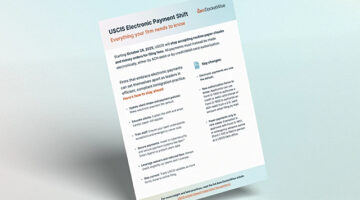A few months ago, I attended a hearing on a motion for a temporary restraining order.
The judge came out on the bench and berated one side’s lawyers: “You filed these papers at midnight last night. Your brief is more than 70 pages long and has a foot of exhibits attached to it. I arrived at court at 9 this morning, and you’re now arguing this at 9:30. Do you really think I had a chance to read this stuff?”
How does this happen? How can lawyers be so silly?

USCIS shift to electronic payments: What immigration firms need to know
As of October 2025, U.S. Citizenship and Immigration Services requires electronic payments for filing fees. Learn key updates, exemptions, and how firms can prepare.
This could well be another sad case of if-I’ve-got-it,-then-by-God-I’m-gonna-inflict-it-on-you syndrome. (I do believe that’s the first time I’ve ever stuck a comma in the middle of a long, hyphenated adjectival phrase. You wonder why I write this column? It’s for the education that it provides me.)
If-I’ve-got-it,-then-by-God-I’m-gonna-inflict-it-on-you syndrome is particularly common at large law firms. That’s probably because they’ve got a lot of stuff, so they have lots of opportunities to inflict things on you.
Think about the 70-page TRO papers. You know those lawyers didn’t sit down yesterday afternoon, start doing research from scratch, and crank out a 70-page brief before midnight. (In the right circumstances, that’s possible, but it wasn’t likely in the case I saw.)

How Filevine Helps In-House Legal Teams Manage Every Matter With Confidence
AI powers tools for data intake, document management, and drafting contracts.
Instead, I bet the lawyers (intelligently) thought they’d save time by looking to see who’d written a brief on a similar issue in the past. The best old brief they found hadn’t been filed at the TRO stage, but instead was the more fulsome brief that’s appropriate for a preliminary (or permanent) injunction hearing. The lawyers (foolishly) ignored their actual situation and thought: “This is great! We have a 50-page brief that beats the living daylights out of this issue. We’ll merge it with a 15-page brief about the standards governing TROs, update the research a little bit, and blow away the other side with one of the finest briefs ever created in eight hours!”
Presto! Another sad victim of if-I’ve-got-it,-then-by-God-I’m-gonna-inflict-it-on-you syndrome.
What’s the problem here?
First, the brief doesn’t fit the situation. Even if it legitimately takes 70 pages to present the best possible argument for your side, you’re running a risk if you file an over-long brief as part of an emergency application. In an emergency, things happen quickly. A typical judge is unlikely to have the time (or inclination) to read a 70-page brief seeking a TRO. Unless you know that your judge is the child of Evelyn Wood and Benjamin Cardozo, don’t file the long-form brief. File the 10-page brief that the judge will read (which gives you a chance to persuade), not the 70-page thing that’s headed straight to the trash.
Second, even if the situation permits the filing of a long brief — perhaps a post-trial motion after a jury trial or an opening brief on appeal — consider whether length works in your favor.
Typically, the best brief is the shortest possible brief. If you really have the goods on me — because, say, the Supreme Court ruled yesterday that a litigant in my position loses — you could probably convince a court of your position in a relatively few pages of argument. The introduction’s pretty easy: “Sad Sack’s position is X. Just yesterday, the Supreme Court ruled that position X loses. [Cite.] Therefore, Sad Sack loses.” The statement of facts need only show that this case is identical to the recent Supreme Court case. The legal argument describes the Supreme Court case, and you’re finished. No muss, no fuss, and you win.
If you really, really, really win, there’s no need to waste 70 pages chatting about circuit and trial court cases, similar cases decided on analogous facts, and assorted policy arguments. Prolixity ain’t persuasion.
(Don’t get me wrong here. You may well have to do exhaustive research to find the few cases from which you will craft your short brief. But don’t lard up a brief with every case you read, thinking that, so long as you read the stuff, you’ll inflict them on the reader. That just doesn’t work.)
How does this apply to in-house lawyers?
First, don’t let your outside counsel suffer from if-I’ve-got-it,-then-by-God-I’m-gonna-inflict-it-on-you syndrome. If counsel suggests filing a brief that’s wonderfully long and impressive, but simply wrong for the occasion, put your foot down. The idea is not to impress people; the idea is to win.
Second, in-house lawyers occasionally possess long and impressive work product. An in-house lawyer may possess a 20-page chronology, a 30-page analysis of all of the legal issues, or a 100-page summary of all of the testimony presented to date at trial. When the head of a business unit asks what’s happening in the case, you must control your if-I’ve-got-it,-then-by-God-I’m-gonna-inflict-it-on-you tendencies. The head of the business unit may need only three paragraphs, or three pages, to serve her purpose. Don’t think you’re helping or impressing people by giving them more information than they need.
Written work must fit the occasion. Think about what your reader needs before bludgeoning the reader with everything you happen to possess.
Let’s stamp out . . . well, you know.
Mark Herrmann is the Vice President and Chief Counsel – Litigation at Aon, the world’s leading provider of risk management services, insurance and reinsurance brokerage, and human capital and management consulting. He is the author of The Curmudgeon’s Guide to Practicing Law (affiliate link). You can reach him by email at [email protected].